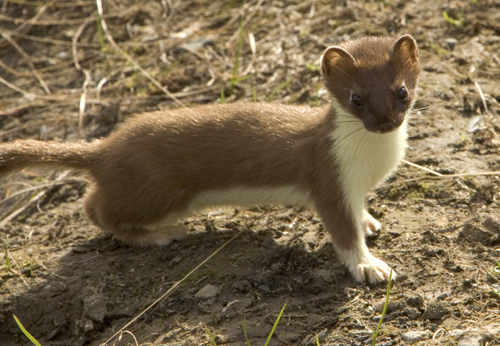Short-tailed Weasels, also called Ermine, and Long-tailed Weasels, are two weasel species very common in Connecticut. They have many similarities and are often difficult to tell apart. The Connecticut DEP conducted a distribution study of these two weasels from 2007 to 2009. DNA samples were needed to confirm the species of a given specimen. Both weasels have the characteristic long thin body and short legs associated with the weasel family. They have scent glands that can produce a pungent musk.
The Short-tailed Weasel or Ermine has brown fur on the top and white fur on their belly. There is a black tip on the end of the 1 1/2 to 3 1/2 inch tail. Their feet are white. In the winter Ermines gradually molt, replacing their brown fur with white except for the black-tip of the tail. In our region weasels molt to white between October and December and back to brown between March and May. The molts are controlled by hormones which respond to the length of the period of daylight. Short-tailed weasels weigh 2 to 6 1/2 oz with bodies 7 1/2 to 13 1/2 inches long.
The Long-tailed Weasel also has brown fur on the top and white fur on their belly. There is a black tip on the end of the 3 to 6 1/2 inch tail. Their feet are brownish. In the winter Long-tailed Weasels also gradually molt, replacing their brown fur with white except for the black tip of the tail. In our region weasels molt to white between October and December and back to brown between March and May. Unlike the Short-tailed Weasel, the molts of the Long-tailed Weasels seem to depend on region. North of Pennsylvania these weasels usually turn white in the winter. South of the Maryland/Pennsylvania border these weasels stay brown in the winter. In a belt across their continental range, some weasels turn white in the winter and some stay brown. Transplanted weasels stick to the molt pattern of their point of origin so the molt seems to be genetically controlled. Long-tailed weasels weigh 3 to 9 1/2 oz with bodies 11 to 22 inches long.
Short-tailed Weasels range through New England, northern Iowa, Michigan and Pennsylvania and in the northwestern corner of the continental US. They range through most of Canada and Alaska. In the 2007 to 2009 Connecticut DEP study, Short-tailed Weasels were found most often in the north and northwestern portions of Connecticut.
Long-tailed Weasels range throughout most of the continental US except for some areas of the southwest. They push their range up into some parts of southern Canada. Long-tailed Weasels were found throughout Connecticut in the 2007 to 2009 Connecticut DEP study.
Both species of weasel inhabit similar habitat consisting of woods, brushy areas, open farmlands and wetlands. Weasels frequently take over a chipmunk burrow. They may also live in the crevices in rock walls or hollow logs. Weasels are usually considered more nocturnal, but can be active both day and night. Short periods of activity, often less than an hour, will be punctuated by several hours of rest. They are active year round.
Weasels are carnivorous and hunt mammals of the size of rabbits and smaller. Their thin bodies allow them to pursue many rodents into their burrows or tunnels underground or under snow. They can also climb trees. Weasels have high metabolisms and require alot of food each day. They will cache extra food to supply their needs. Therefore weasels will instinctively kill what food is available and store what they can't eat right away. This gives them their reputation as particularly ferocious hunters and is the behavior that leads to the notorious killing sprees sometimes enacted by weasels in a hen house. Weasels will also eat eggs, frogs, fish and insects when they cannot find a meal of meat.
Short-tailed Weasels breed in the late spring or early summer, after producing a litter in April or May. Implantation of the embryos is delayed 9 to 10 months so that their next litter is born the following spring.
Long-tailed Weasels breed in mid-summer, also after producing a litter in April or May. They also experience delayed implantation.
Weasels are not monogamous and females care for the pups alone.
Weasels are solitary except while mating and raising young.
Neat Fact
It has been claimed that weasels suck the blood out of their prey. They do not, but their habit of licking the blood from the wounds and fur of animals they have killed may have led to this belief.

